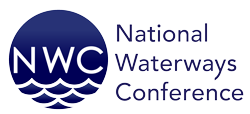History
NWC History
The National Waterways Conference was originally created in 1960 as an inland users waterways group to fight the administration’s proposal to institute a user fee along the inland waterways system. Since then, NWC has morphed into the only national organization to represent a diverse group of members across all water and waterways resource interests.
Waterway User Charge Proposals Triggered NWC’s Founding
In 1955, the Second Hoover Commission on Organization of the Executive Branch of the Government recommended that Congress “authorize a user charge on inland waterways… sufficient to cover maintenance and operation,” with the Interstate Commerce Commission empowered “to fix such charges.” The recommendation sent shock waves up and down the nation’s waterways.
American Waterways Operations, then just 11 years old, promptly called a meeting of navigation interests. There, representatives of some 40 waterways shippers and carriers, port, civic, and industry groups decided that a separate organization should be formed for the sole purpose of defeating any attempt to impose user charges on inland waterways and that the new organization would be known as the National Waterways Conference.
This informal federation of waterway-related organizations would be dedicated to the preservation of historic toll-free waterways policy. Under the direction of a 10-member steering committee, the Conference began preparing materials on the benefits of America’s “free waterways” and their importance to economic growth and development. Committee members briefed their Members of Congress, visited local newspapers, and made numerous luncheon speeches.
In 1956, President Eisenhower set up an Interdepartmental Committee on User Charges. In 1957, the Bureau of the Budget (now OMB) directed the Department of Commerce to examine “the question of imposing charges” on inland navigation. In 1958, the Senate Committee on Interstate and Foreign Commerce authorized a report on national policy dealing with Federal assistance for transportation modes and the desirability of assessing user charges.
March 1960 brought a bombshell, when Commerce Secretary Frederick H. Mueller advocated full waterway cost recovery, beginning with “low-level fuel taxes” followed by annual increases over a period of years.
The time had come to act. From the earliest days of the nation’s history, the federally improved and maintained U.S. inland waterways had been entirely free from tolls or user charges. Over extensive regions, communities, and industries, millions of workers and farmers derived their livelihood from activities dependent on this policy.
But these far-flung interests had no single spokesman. While a number of regional water resource associations and water carrier groups were responding vigorously to the Mueller proposal, albeit with helpful guidance from their ad hoc federation, the original National Waterways Conference. But with no staff and meager funds, the loose-knit organization was unable to respond adequately to the mushrooming challenges.
Lacking overall coordination, many individual companies and local interests joined the fray; most were directly concerned with water transportation so user charge advocates attacked their statements as special interest pleading. The widespread community and shipping interests involved in waterway and port programs urgently needed some agency to state their views with a single voice.
In September, 1960, representatives of shippers, development and trade associations, and water carriers participating in the original National Waterways Conference met to plan a full-scale counter offensive against this rapidly mounting campaign for waterway tolls. There, the Conference’s organization was formalized as a corporate, independent waterway-oriented association charged with coordinating the anti-tolls fight and otherwise supporting the waterways industry.
Later that month, an organizing committee met in Chicago to draw up plans for a permanent membership organization of shippers, barge lines, trade and development associations, ports, and Chambers of Commerce to carry out a program of research, study, and analysis concerning the inherent advantages, economies, and public values of the inland waterway system.
With the foundation set, a formal organizing committee met and set up the new National Waterways Conference, Inc. In calling the meeting, Braxton B. Carr of the American Waterways Operators said the Conference’s intent was “to supplement the work of existing organizations in a national program designed to coordinate the efforts of everyone interested in the development, presentation, and use of the waterways of the United States.”
The 62 people who attended that meeting came from 20 different states across the nation. Of the attendees, 27 were waterway shippers or representatives of shipping associations who spoke for coal mining, petroleum production and refining, farm marketing, farm supply industries, chemicals, and other basic industries. Still other participants represented recreational boating, community and local government interests, multi-modal interchange terminals, and port authorities. Only 11 of the 62 were water carriers. Six others represented regional river valley associations.
No longer did they have to stand alone.
Contributed by Harry N. Cook, President Emeritus, NWC with material from History and Accomplishments of the National Waterways Conference, Inc., 1960-1985
